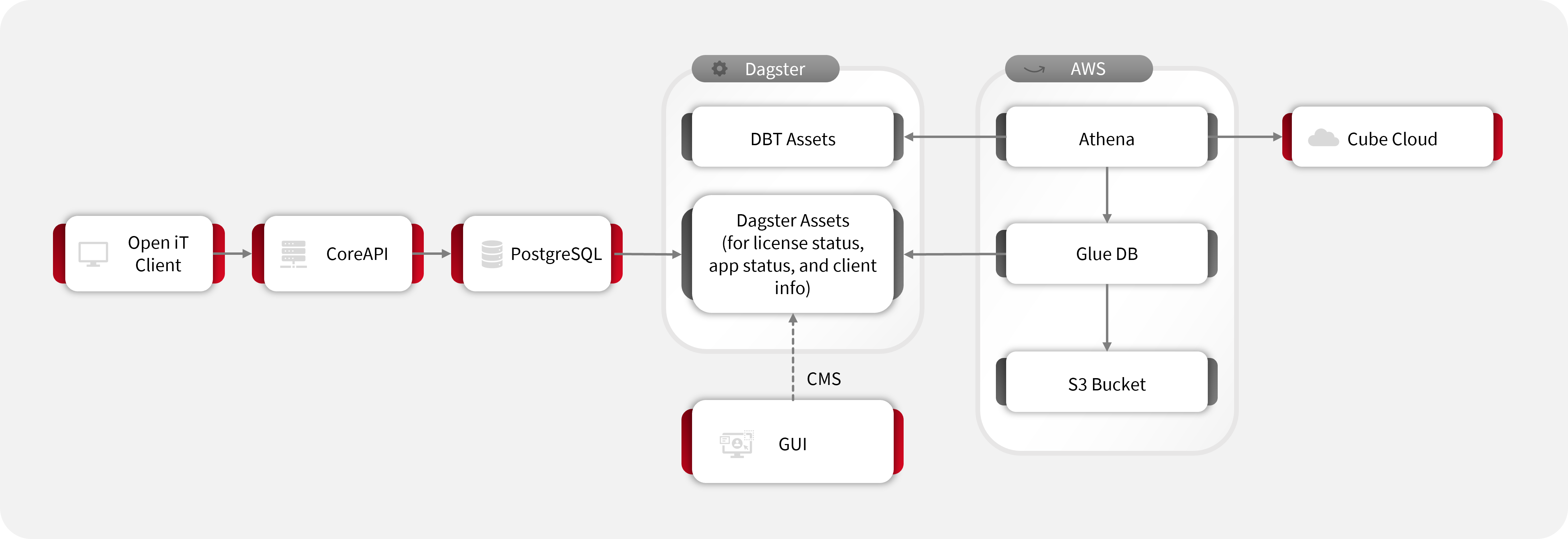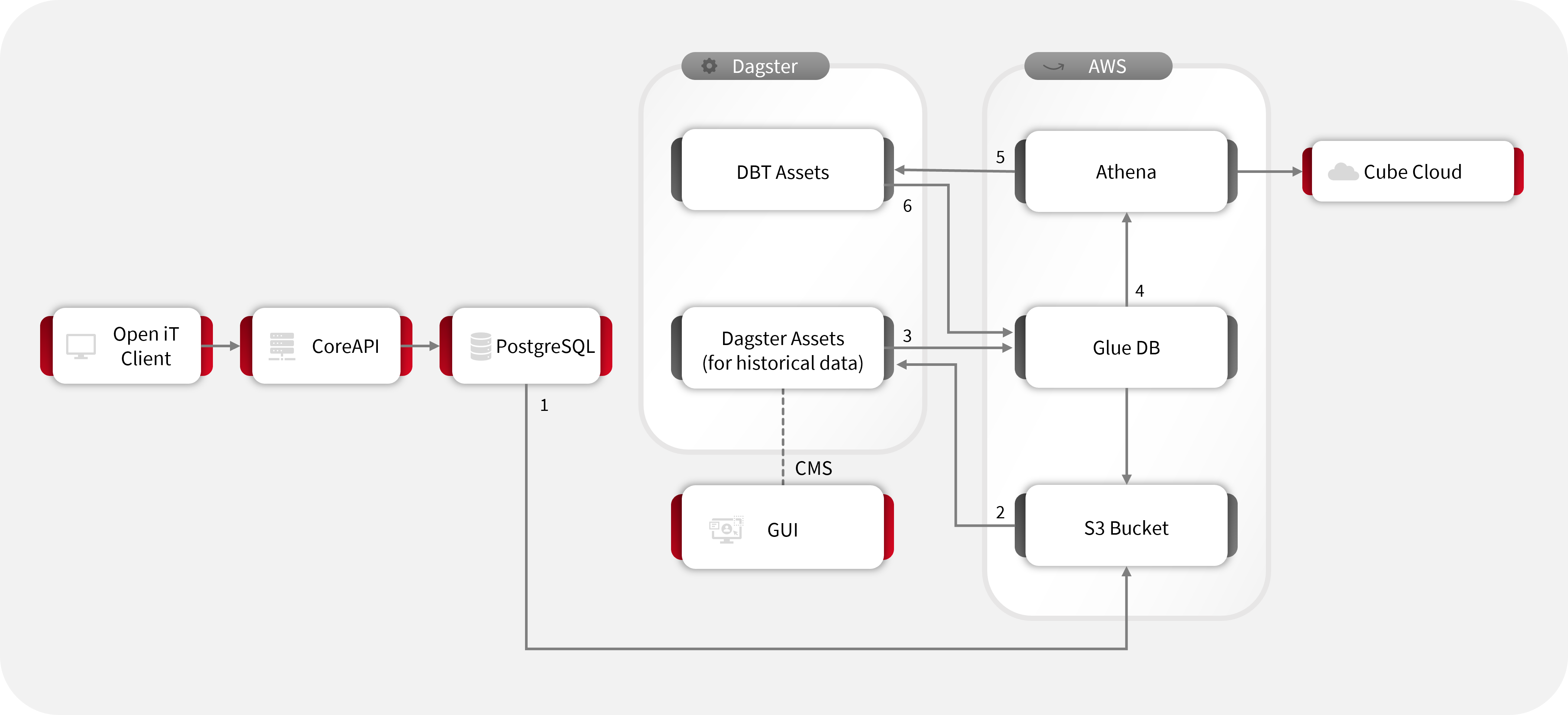Getting Started
What is Open iT?
Open iT Data Flow
Real-time Reporting
Open iT has a License Monitor. It's a centralized, real-time dashboard that empowers organizations to monitor software license activity as it happens. Designed for both administrators and end users, it provides immediate insights into license expiration status, usage patterns, and individual application activity—allowing for faster decisions, reduced downtime, and optimized resource allocation.
This feature plays a key role in helping organizations maintain software compliance, reduce costs, and ensure uninterrupted access to critical tools.
How it Works:
The License Monitor provides real-time visibility into license activity through a streamlined, multi-stage data pipeline that ensures accurate and timely reporting. Here's how raw usage data is captured, processed, and transformed into actionable insights:

The system starts by collecting license usage and client activity data through the Open iT Core Client. This data is sent through CoreAPI and stored securely in a database. An orchestrating tool called Dagster regularly processes this data based on the information from the GUI, organizing it into meaningful assets, like license status, application usage, and client details. In the background, the system also prepares deeper reporting data using transformation tools (like DBT) and stores it in the cloud (AWS). There, services like Athena and Cube Cloud make it easy to run queries and generate advanced reports. All of this is automated and integrated to ensure that you can monitor usage, spot issues, and make data-driven decisions without needing to dig into raw data or technical systems.
Suggested Reading: License Monitor
Historical Reporting
Open iT offers built-in support for historical reporting, giving organizations a clear view of long-term license usage trends. From audit-ready summaries to deep-dive analysis, users can explore years of data through interactive dashboards powered by tools like Superset, enabling more intelligent planning, easier compliance, and better decisions backed by real usage insights.
How it Works:

The system starts with the Open iT Core Client collecting license and application usage data, which is ingested via CoreAPI and stored in a PostgreSQL database. From there, Dagster orchestrates the movement of data through the system. It extracts data from PostgreSQL and pushes it to an AWS S3 bucket for cloud-based processing. The data is then cataloged in AWS Glue, making it queryable through Amazon Athena. At the same time, Dagster generates assets for historical data based on the configuration from the GUI. For advanced transformation, DBT runs within Dagster to clean and structure the data further, which is written back to Glue for downstream querying. Finally, Cube Cloud connects to Athena to deliver fast, flexible analytics and dashboards for reporting and monitoring purposes.
Additional Software
The following unmodified tools are included in the Open iT software product or used by the Open iT software:
- RavenDB
- Hangfire
- Quartz
- Monaco Editor
- Highcharts/ Highstock
- jQWidgets
- Casbin
- Redis
- Perl
- AWS Athena
- AWS Glue
- AWS s3
- Dagster
- gRPC
- dbt
- Apache Iceberg
- PostgreSQL
- Marten DB
- kubectl
- Terraform
- Docker
- Helm
- Argo CD
- External Secrets Operator (ESO)
- AWS Secret Store
- Karpenter
- AWS EKS
- Prometheus
- Grafana
- Loki
- Reloader
- AWS IAM
Feature Highlights
-
Cloud-Ready Infrastructure: Open iT runs on a containerized, cloud-ready architecture that standardizes build, deployment, and runtime processes for consistency and simplicity across environments using Docker, Kubernetes, Terraform, Helm, and PostgreSQL.
-
Centralized Data Pipeline: Features centralized orchestration and lineage tracking with Dagster providing:
- Structured, end-to-end workflow visualization
- Dependency mapping
- Consistent issue detection
-
Unified User Interface: Offers a fully centralized and intuitive UI for:
- Streamlined navigation
- Simplified configuration
- Efficient system management
-
Seamless Integration: Includes a broad API compatibility that enables seamless integration with customer and partner tools by exposing data through GraphQL, REST, SQL, MDX, or DAX with Cube Cloud.
-
Enhanced Reporting Capabilities: Built on modern technologies to deliver richer and more flexible reporting tools such as Apache Superset.
-
Generative AI-Powered Assistant: Enables conversational, natural language interaction to:
- Simplify onboarding
- Reduce support dependency